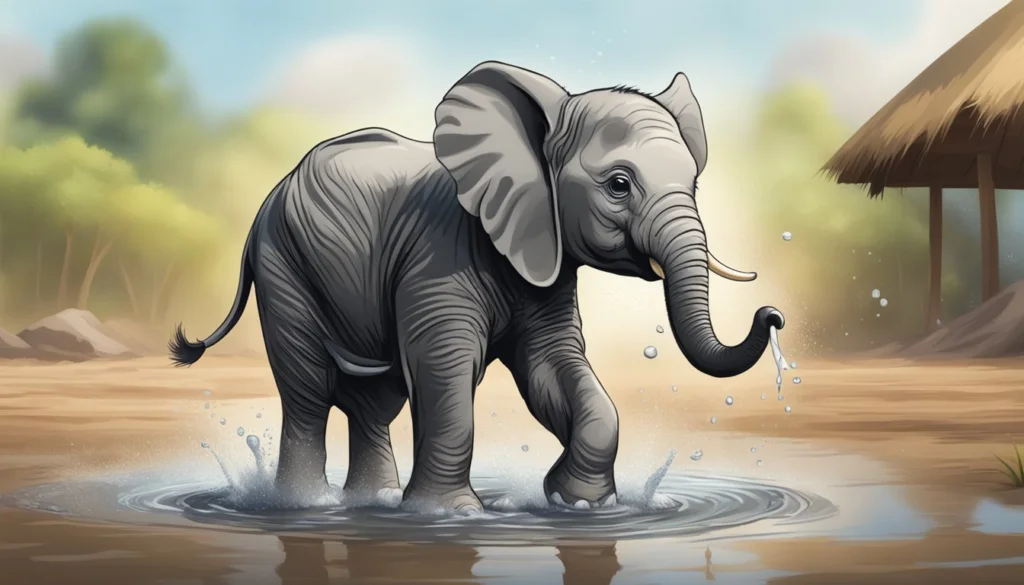Baby elephants, also known as calves, are some of the most adorable and fascinating creatures in the animal kingdom. Born into close-knit family groups, they quickly learn the ropes of elephant life under the watchful eyes of their mothers and other members of their herd. With their large floppy ears, playful personalities, and undeniable curiosity, baby elephants never fail to capture the hearts of anyone who encounters them.
In this article, we’ll explore the life of baby elephants, from birth to maturity, and how they develop the skills needed to survive in the wild. From their unique physical characteristics to their behaviors and social structures, baby elephants are a marvel of the natural world.
The Birth of a Baby Elephant
Elephant calves are born after one of the longest gestation periods in the animal kingdom, lasting 22 months. The lengthy pregnancy allows the baby elephant to develop fully before birth, ensuring that it is ready to face the challenges of life in the wild.
1. The Longest Gestation Period
Elephants, particularly African and Asian elephants, have the longest gestation period of any land mammal. This long pregnancy allows the baby elephant to grow and develop within the mother’s womb, preparing it for survival in the harsh environments of Africa or Asia.
2. Size at Birth
At birth, baby elephants weigh an average of 220 to 250 pounds (100 to 115 kg) and stand about 3 feet (90 cm) tall. Despite their size, they are incredibly vulnerable at birth and rely entirely on their mothers and herd members for protection and care.
3. Calving in the Herd
Elephant births typically occur in the company of other females in the herd. This is a protective measure, ensuring that the newborn calf has multiple caregivers and protectors. Female elephants in the herd, including aunties, often help the mother during labor and stay close by to provide support immediately after birth.
Physical Characteristics of Baby Elephants
Baby elephants are easily recognizable by their wrinkly gray skin, large floppy ears, and small trunks. While they resemble miniature versions of adult elephants, calves have some distinct physical traits that help them adapt to their environment as they grow.
1. The Trunk
One of the most distinguishing features of any elephant is its trunk, and for baby elephants, learning how to use this incredible appendage is a major part of early development. At birth, calves have little control over their trunks and often struggle to figure out how to use them. You’ll often see baby elephants tripping over their own trunks or playing with them, slowly mastering the movements needed to drink water, feed, and pick up objects.
The elephant trunk is a versatile tool used for everything from sucking up water and picking up food to communicating with other elephants. As the calf grows, it will gradually gain control over its trunk, using it for a variety of tasks essential for survival.
2. Ears
Like adult elephants, baby elephants have large ears that help them regulate their body temperature. By flapping their ears, they can cool down their blood, which is crucial for staying cool in the heat of the savannah. For African elephants, their ears are especially large compared to their Asian counterparts, acting as natural air conditioners.
3. Tusks
Elephants are known for their tusks, but baby elephants are born without them. In African elephants, the tusks start to emerge when the calf is about 1 year old, growing slowly over time. For Asian elephants, only the males develop tusks, and they may take longer to appear. During their early months, baby elephants don’t need tusks, as they rely on their mothers for protection and food.
Social Structure and Family Life
Elephants are highly social animals, and baby elephants grow up in close-knit family groups known as herds. These herds are matriarchal, meaning they are led by an older female, usually the mother or grandmother of the younger elephants. Baby elephants are born into this social structure, and their interactions with other herd members play a critical role in their development.
1. Matriarchal Society
Elephant herds are typically made up of related females and their offspring. The matriarch, usually the oldest and most experienced female, leads the herd and makes important decisions about where to find food and water, as well as how to respond to threats. Baby elephants look to the matriarch for guidance and protection as they grow up.
2. Mother and Calf Bond
The bond between a mother elephant and her calf is one of the strongest in the animal kingdom. From the moment of birth, the mother is fiercely protective of her baby, keeping it close by and helping it learn the necessary survival skills. The mother feeds the calf with breast milk, which is rich in nutrients, for the first two to three years of its life, though calves will begin to sample solid food after just a few months.
This bond is not only essential for the calf’s survival but also for its emotional and social development. Baby elephants rely on their mothers not just for physical nourishment but also for comfort and reassurance.
3. Aunties and Helpers
In elephant herds, it’s common for other females to assist in the care of the calf. These “aunties” help the mother by watching over the calf, protecting it from danger, and even assisting with feeding in some cases. This communal approach to raising young ensures that the calf has multiple caregivers and is well-protected within the herd.
4. Play and Learning
Baby elephants are curious and playful, spending much of their time exploring their surroundings and interacting with other calves in the herd. Play is an essential part of their development, helping them build strength and coordination while also learning important social skills. Calves often engage in mock battles, chasing games, and trunk wrestling, all of which help them practice the behaviors they’ll need as adults.
Feeding and Weaning
For the first several months of life, baby elephants rely exclusively on their mother’s milk for nourishment. This nutrient-rich milk helps the calf grow rapidly, gaining weight and strength. However, as the calf grows older, it gradually begins to eat solid food while still nursing.
1. Breastfeeding
Baby elephants are breastfed by their mothers for the first two to three years of life. During this time, the mother’s milk provides the essential nutrients needed for growth and development. Nursing is a frequent activity, and calves will drink their mother’s milk several times a day.
2. Introduction to Solid Food
At around four to six months old, baby elephants begin to experiment with eating solid food, including grasses, leaves, roots, and bark. During this transitional phase, they continue to nurse while learning how to forage and use their trunks to gather food.
3. Weaning
Weaning typically occurs when the calf is around two to four years old, though the exact timing can vary depending on environmental conditions and the mother’s health. Once fully weaned, the young elephant will rely entirely on solid food and must develop the skills needed to feed itself in the wild.
Challenges and Threats Facing Baby Elephants
While baby elephants are born into supportive and protective herds, they still face many challenges and threats in the wild. From predators to environmental hazards, survival is not guaranteed, and the first few years of life are critical for a calf’s development.
1. Predators
Although elephants are large animals, baby elephants can fall prey to predators like lions, hyenas, and crocodiles, especially if they become separated from the herd. The herd’s protective nature helps safeguard the young, but predators may target vulnerable calves if they are left unattended.
2. Human Encroachment
Human activities, such as habitat destruction, poaching, and conflict with farmers, pose significant threats to elephant populations. Baby elephants are particularly vulnerable when they lose access to their natural habitats or when their mothers are poached for ivory. In recent years, conservation efforts have focused on protecting elephant habitats and reducing poaching to ensure the survival of future generations.
3. Drought and Lack of Resources
In areas where food and water are scarce, baby elephants may struggle to get the nutrition they need. Long droughts can lead to food shortages, and in extreme cases, young elephants may not survive without access to sufficient water and food.
Fascinating Facts About Baby Elephants
- Born Walkers: Within minutes of being born, baby elephants can stand and walk. This quick mobility is essential for keeping up with the herd and avoiding predators.
- Highly Social: Baby elephants form strong bonds not only with their mothers but also with other members of the herd. They rely on these social connections for learning and protection.
- Trunk Trouble: Baby elephants often struggle to control their trunks in the early stages of life. They will playfully swing their trunks around or even trip over them until they gain full control.
- Milk-Dependent: Elephant calves rely on their mother’s milk for up to two years, though they begin eating solid food at around six months.
- Long Childhood: Elephants have a prolonged childhood, staying with their mothers and family groups for up to 10 years before becoming fully independent.
Conclusion
Baby elephants are not only incredibly cute but also vital to the survival and growth of elephant populations. From their birth in tightly knit family groups to their playful interactions and the essential life lessons learned in the herd, baby elephants lead a fascinating and complex life. Despite the challenges they face, their resilience and the support they receive from their mothers and herd members ensure they have a good chance of thriving in the wild.
With increasing conservation efforts, we can hope that these amazing creatures continue to live and grow in their natural habitats for generations to come.
FAQs
How much does a baby elephant weigh at birth?
Baby elephants typically weigh between 220 to 250 pounds (100 to 115 kg) at birth.
How long do baby elephants nurse?
Baby elephants nurse for about two to three years, but they begin eating solid food around six months of age.
Are baby elephants born with tusks?
No, baby elephants are born without tusks. In African elephants, tusks begin to emerge when the calf is around 1 year old, while only male Asian elephants develop tusks later in life.
How long do baby elephants stay with their mothers?
Baby elephants stay with their mothers and herd members for up to 10 years, although they become more independent after around 3 to 4 years.
What are the biggest threats to baby elephants?
The biggest threats to baby elephants include predators, habitat loss, poaching, and drought. However, with the protection of their herd and increased conservation efforts, many calves can grow into healthy adults.


